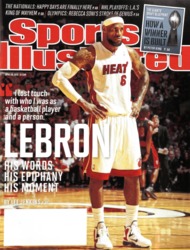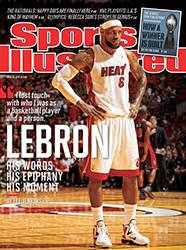
STROKE OF GENIUS
Rebecca Soni has heard it all her life: You shouldn't be that fast. At 5'8", Soni is small for an elite swimmer. Her pull isn't notably strong and neither is her kick, and when she puts them together her stroke doesn't look anything like that of other world-class breaststrokers. When Soni was an age-group swimmer with the Scarlet Aquatic Club in Piscataway, N.J., one official at a premeet meeting declared to the others, "The girl on Scarlet does an illegal breaststroke. I can't put my finger on it, but girls can't swim that fast, so it must be illegal."
Illegal? No. Unusual? Without a doubt. Where others surge through the water with long glides, Soni skims along the surface like a water skeeter, her abbreviated pull and narrow snap kick giving her a quick tempo few swimmers can maintain. Her coach at USC-based Trojan Swim Club, Dave Salo, calls the motion she creates "teeter-tottering," and it is a study in timing and efficiency. "After she's kicked and before she's pulled, that part where people don't think anything is happening, she's still moving forward," says 2012 U.S. Olympic women's coach Teri McKeever. "That's where Rebecca is better than everybody else."
Unlike Mike Barrowman, the Olympic champion who revolutionized the stroke back in the late 1980s and early '90s with his more up-and-down, "wave-action" stroke, which many breaststrokers do some version of today, Soni is not attracting legions of imitators. "I think if you were to explain her stroke to most swimmers, they'd say that's not going to work for them," says breaststroker Eric Shanteau, a 2008 Olympian. "I know it wouldn't work for me. But for Rebecca, it works."
It has worked so well for Soni that, at 25, she is the owner of a gold and two silver Olympic medals, six long-course world-championship medals (including four golds), a raft of endorsement deals and the title of Breaststroke Queen. At this summer's Olympics in London, she'll be the favorite in both the 100- and 200-meter breaststrokes.
Friendly but reserved—"Quiet but always processing," says her sister, Rita—Soni isn't inclined to make promises about her performances. Aside from her racing, she does little that draws attention to herself. In her free time she likes to cook, read (Ayn Rand is a favorite author), listen to country music, study nutrition, play with Kody, her black chow mix, and hang out with her boyfriend, 2008 4 √ó 200-freestyle-relay gold medalist Ricky Berens. In her role as volunteer assistant coach at USC, she serves as the team's spin class instructor twice a week. She spends a lot of time choreographing music "so it'll be fun for them," she says, but very little time chewing out laggards. "Rebecca," says friend and fellow U.S. star Dana Vollmer, the reigning butterfly world champion, "is the sweetest, kindest person I know."
But behind that cheerful, calm facade is a fierce competitor, says Salo. "Someone asked me what animal I would characterize her as, and I said a lioness," he says. "There's that quietness, but you know if she wants to strike, you're going to get full bore."
As for that Olympic double, "if it happens, it happens," says Soni. "The focus for me is getting there, having a good time. I had a great time in Beijing; I want to enjoy the experience again."
Favorite status is not yet a comfortable fit for Soni, though she handled it well at last summer's world championships in Shanghai, where she swept the 100 and the 200 and was part of the first medley-relay gold medal for the U.S. women at a major competition since 2000. "She tries to downplay her stardom," says Berens. "She hates being in the spotlight. She just likes to mind her own business, do her own thing. She'll pay attention to what swimmers in other countries are doing, but she doesn't say, 'That's slow, that's slow.' She'll say, 'Oh, they're coming up, they're coming up.' She doesn't like being the favorite."
Soni rarely gets to feel like one in her daily practices at USC, where she trains with a large postgraduate group that is predominately male and includes some of the world's best breaststrokers, such as Japan's quadruple Olympic gold medalist, Kosuke Kitajima, Shanteau and Jessica Hardy, the world-record holder in the 100 breast, who is also a top freestyle sprinter. Soni often trails the group in practice, especially in kicking sets. "She is working as hard as she can, but she's not an impressive trainer," says Salo. "But when she steps up on the blocks to race, she has a different mind-set. She goes into a gear that most people are unwilling to sustain."
In the last leg of a 200-meter race, the water skeeter morphs into something else. Jack Bauerle, the 2008 Olympic women's coach, recently watched a clip of Soni's world-record-setting 200-breaststroke race in Beijing. "On that last 50 she's like a freight train," he says. "She gets more momentum, more momentum.... It's like she's going downhill while everyone else is swimming up."
What Soni has always loved most about swimming is the hard work, the exhaustion she feels at the end of a workout and the feeling of accomplishment it gives her. Before she had an ablation to correct the condition in 2006, she would occasionally suffer a bout of super ventricular tachycardia, a non--life threatening heart arrhythmia, in the toughest stretch of a practice. The worst part was not the discomfort of her heart suddenly revving up to over 200 beats per minute and the fatigue and sluggishness that followed; it was "sitting on the side as my teammates finished off a hard set," she says.
Her parents, Kinga and Peter, Hungarians who immigrated to the States from Romania in the 1980s, wanted their daughters to participate in a sport they wouldn't outgrow as teens, so at age 10 Rebecca followed Rita from gymnastics into the pool. Within three years she was so devoted to her new sport that she stopped the piano lessons she had been taking since she was five (ever thorough, she made sure she could play Mozart's Piano Concerto in C, the song her mother always played, before she quit) and started training with the Scarlet Aquatic Club, about 40 minutes from her home in Plainsboro. "When she got here, she had a very different stroke, she was throwing her hands out of the water," says Scarlet coach Tom Speedling. "I like to tell the kids about how Michelangelo would look at a piece of marble and see the David in it—he just cut away the excess stuff that wasn't necessary. That's what we did with her stroke; we tried to base it on her core strength. She didn't need a full pull. With the kick, we worked on keeping her knees together and doing a snap kick with the lower leg. If you have a wider kick, it eliminates some of the [benefits of a strong] core."
Given Soni's relatively petite size, her race strategy had to be unusual too. "Our goal was, dive in, quick pullout and get going," says Speedling. "Rebecca is probably on her third stroke by the time a swimmer like Kristy Kowal [the six-foot-tall 2000 Olympic silver medalist in the 200 breaststroke] would come up and take her first stroke."
Soni made her first nationals cut at 13. Five years later she won the 200 breaststroke at the 2005 nationals, crushing the field by three seconds. She went off to USC, where she became the first woman to win four consecutive NCAA 200-yard-breaststroke titles. (She also won two 100-yard championships.) Yet when the summer of '08 rolled around, she was still unknown outside the swimming community. At the Olympic trials in Omaha, she won the 200 breaststroke but came in fourth and failed to qualify for the team in the 100 breast despite turning in the fastest semifinal time. It was only after the team arrived in China that Soni learned she would be in the 100 field after all, as the replacement for Hardy, the trials champ, who had withdrawn from the team because of a positive test for clenbuterol. (The American Arbitration Association eventually accepted Hardy's explanation that the clenbuterol came from a tainted supplement and gave her a one-year suspension rather than the standard two-year ban.) "I thought, I'm just going to swim the race, use it as a warmup for the 200 breast," says Soni. "I didn't worry because I wasn't supposed to swim it anyway."
In the final on Aug. 12, she came in a surprising second to Australia's Leisel Jones, who was then the world-record holder in both breaststroke events. Three days later she blew away the 200 field, beating runner-up Jones by nearly two seconds and setting a world record of 2:20.22. "I never thought anyone was going to catch Leisel," Soni says. "Then I mess up and touch first. I didn't know what to feel. Of course I was thrilled, I was excited. I didn't plan for it to happen, but it was the best race of my life."
A year later she had the worst. After watching other swimmers, in her words, "fly by" at the 2009 world championship trials in Indianapolis, she finally gave in to the rubberized-suit craze and struggled into one of the corset-like outfits between prelims and finals of the 100. "I hated the bodysuits," says Soni. "I didn't feel comfortable, I didn't feel like I was in control. They were a pain. It was literally half an hour of sweating, hard work to put them on your body."
Wearing the suit in the 200 breast final at worlds in Rome, she jumped out to a huge lead, turning in a 100 split that would have won the bronze medal in the 100. "The suit made the race feel easier than it probably was," she says. At 150 meters she was in front by 2.45 seconds. Midway through the final lap, however, she slowed down drastically, completely spent. After Soni finally touched the wall in fourth place in 2:22.15, she clung to the lane line, barely able to move.
She no longer has to worry about the rubberized suits—they've been banned since 2010—or the advantage she felt it gave other swimmers, who don't have the core strength she has developed through hours of Pilates and yoga. While many of her competitors' times have not approached the records they established in the suits, Soni has come close to setting new world marks in both breaststroke events. At the 2011 worlds she was tantalizingly close in the 100 semifinal, finishing in a "textile-best" (referring to all swims not made in a high-tech suit) of 1:04.91, just .46 of a second off Hardy's '09 world record. In the 200 breaststroke semifinal, she was just .91 off Canadian Annamay Pierse's world mark of 2:20.12, also from '09.
The expectation for new standards will follow Soni to London. She is aware of that but doesn't dare embrace it out loud. "I know I've been very lucky with my stroke, with the coaches I've had," she says. "I don't take any of it for granted." Breaststroke Queen? That's not a crown she wants to claim just yet. For now she plans to quietly keep working like the swimmer who shouldn't be that fast.
PHOTO
Photograph by HEINZ KLUETMEIER
WATER SKIMMER Her coach refers to Soni's unorthodox motion (left, top) as "teeter-tottering," and the key to its success lies in the stroke's quick tempo and Soni's ability to maintain a pace that other swimmers either can't or won't.
PHOTO
PETER READ MILLER
[See caption above]
PHOTO
JOHN W. MCDONOUGH
MEDAL TESTED Soni (center) upset Australian world-record holder Leisel Jones (left) in the 200-meter breaststroke in Beijing, lowering the world mark to 2:20.22. In London, Soni will be the favorite in both the 100 and the 200.

